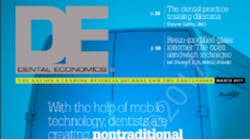The making of a successful referral-based practice
Being a good dental specialist does not necessarily make you a successful dental specialist. Referrals—and more importantly, relationships with referring dentists—are the key to success. Louis H. Berman, DDS, FACD, shares his advice for building a successful referral-based dental practice.
After more than 30 years owning a successful endodontic practice, I have found that the art of creating and maintaining a successful referral-based practice may be just as important as how well we do our clinical treatment. After all, without our dedicated referrals, we might as well just close our doors. Here are a few observations for my fellow specialists on how to grow a referral-based practice.
Practice presentation
Office image—from the way your practice looks to the way your staff behaves—is paramount. You are a specialist, but you are also an extension of the referral's office. As such, the last thing you want to do is lose patients because of deficiencies with their first contact to your office. The person answering your phone is not just a reflection of you, but is also a reflection of your treatment. Role-playing is great practice for the receptionist, whose persona should be proficient, efficient, friendly, and compassionate. This team member should have good knowledge of the procedures being offered, the time involved, and the financial obligations of the insurance and the patient. Your receptionist is the first exposure to your office. His or her demeanor and appearance will be assessed by the patient within seconds. Perception is everything, and you never get a second chance for a first impression—that should be the theme song for every specialty referral-based practice.
Unfortunately, people judge a book by its cover. You are a specialty practice: look special! Patients will be visiting your office, and quite often the referring doctor or staff will be visiting your office, too. It has to look "a cut above," not dated or sloppy. Your presentation will affect patients' impressions of your clinical abilities.
Internal marketing
Your goal is to impress the patient and the referring doctor's office. Excellent clinical abilities and results are just the beginning, and by themselves, not enough to sustain a referral-based practice. Outside of your clinical treatment, the other things you do in your office that set you apart from local competitors can be termed "internal marketing." This encompasses many parameters, but to start, consider the quality, ease of use, and appearance of your office forms. A patient registration form that looks like it's been through the copier a thousand times is not what you want a new patient to see when they first arrive at your office.
It may be difficult to coordinate at times, but a "send them right over" policy is a huge gift to any referring office that has patients with "hot teeth"—not to mention, the patients will love you forever and tell all their friends. Few dentists want to deal with a patient who is swollen or in pain, but that is your bread and butter as a specialist. Nothing fosters a referral relationship like making everyone's day just a little bit better. After-hours emergency coverage and follow-up phone calls after treatment are also a huge "medal of honor" for the specialist. It does not take a lot of effort, and the perception that you care becomes pervasive.
Help market your referral. Don't be shy about telling patients how great their dentist is. Trust me: if you tell patients that their dentist did an awesome crown or veneer, they will most likely tell their dentist what you said.
External marketing
I'll bet you think I'm going to tell you that you should ask all of your referring dentists out to lunch, right? Wrong. Most dentists are pretty busy. They may be uncomfortable meeting you if they don't know you, and they may feel rushed to get back to their after-lunch patient. Instead, drop off bagels just before lunch, or send over breakfast snacks. Have posttreatment reports to send? Every now and then, don't mail or e-mail them; hand deliver them. Engage your referrals' staff, but make sure you're not annoying them. Sometimes, that's a tough balance.
So, who is the gatekeeper to your office? Many times it's the receptionist from the referral's office. Have your office manager connect with this person as often as reasonably possible. We have even hosted after-work "happy hours" when we host 20-40 receptionists from multiple referral offices. Have it at a local restaurant. Have it at your office. It's nice to be recognized with a drink, after-hour snacks, and good company. Interpersonal relationships like this foster camaraderie, familiarity, and above all, trust. It also shows the referral's staff that your team members have a lot of pride working with you.
Visibility
There is no such thing as overexposure when it comes to building a referral relationship. Become active or start up a local dental study club. Give presentations at your local or state dental society meetings. Be visible within the dental and nondental communities. See a novel journal article that may pertain to a case you're working on with your referral? Send or e-mail the article to them with a quick note. When you look like the expert, you'll be perceived as the expert.
Making the transition
Your referrals may give their patients options for a few specialists. Today's prudent shopper will judge you based on what they read and see. Your referral form (the marketing material that you give the referring office to give to their patients) is key. It must be professionally done with plenty of self-serving features that draw that patient to your practice in the midst of the competition. And, of course, your website has to be stellar and informative.
Communication
Effective communication with your referral is critical, especially if the case is a little left of center with respect to diagnosis, treatment, or patient management. But also keep in mind what not to say. Questioning a referral's treatment plan without communicating with the referral is a huge faux pas. Worse yet is telling the patient something like, "You know, there is decay under that crown," when you did not realize that the crown was just done last week. What do you think that patient will say to your (now forever lost) referral? Or how about if you say, "I can't put you to sleep for your root canal, but there is a general dentist down the street who does both sedation and root canals." You can kiss that referring dentist goodbye. And when your referring doctor perforates during their endodontic access or leaves in a root tip after an extraction, how will you handle that? Diplomacy and prudence will go a long way, even though it's often a tough balance between ethics and ego.
Putting it all together
Being a good specialist may not make you a successful specialist. Remember that nice guys finish first, you never get a second chance to make a good first impression, and understand that people do judge a book by its cover. The key to creating and maintaining a successful referral-based practice is ensuring that you maintain the highest level of presentation, perception, professionalism, and quality of care. Always push to be on top and never feel comfortable that your office is on autopilot. After all, your referring offices are the ones who ultimately pay your salary!
Louis H. Berman, DDS, FACD, has lectured internationally in the field of endodontics and has published in several peer-reviewed dental journals. He is the coeditor and contributing author of Cohen's Pathways of the Pulp. A board certified-endodontist and Fellow of the American College of Dentistry, Dr. Berman has been in full-time private practice in Annapolis, Maryland, for the past 33 years. He may be contacted at [email protected].

